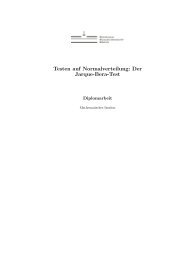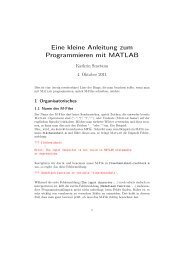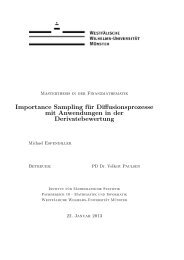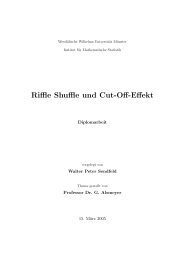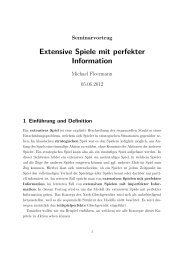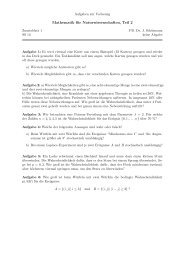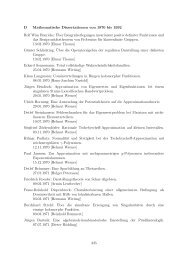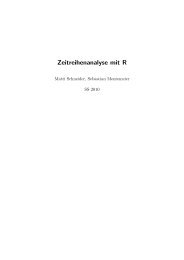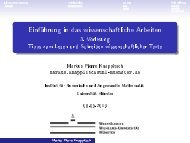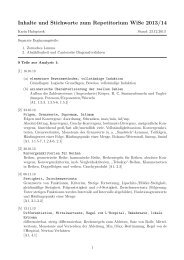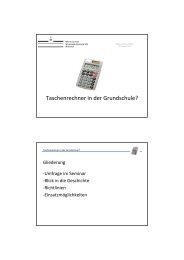Margulis Lemma
Margulis Lemma
Margulis Lemma
You also want an ePaper? Increase the reach of your titles
YUMPU automatically turns print PDFs into web optimized ePapers that Google loves.
STRUCTURE OF FUNDAMENTAL GROUPS 23<br />
Let q 1 , . . . q l be a maximal r/2-separated net in B Lr (p). Note that<br />
l⋃<br />
B Lr (p) ⊂ B r/2 (q m ).<br />
m=1<br />
By a standard volume argument we can deduce from (12) that<br />
(13)<br />
∑ l<br />
m=1 vol B r/2(q m )<br />
≤ 3 k+1 ≤ 3 n .<br />
vol B Lr (p)<br />
Fix q m and consider the following vector field<br />
k∑<br />
X(x) = (b i α(p) − b i α(q m ))∇b i α(x).<br />
α=1<br />
Since b i α are Lipschitz with a universal Lipschitz constant by (1), X satisfies<br />
(14) |X(x)| ≤ C(n) · Lr.<br />
Also, by construction, X satisfies<br />
(15) Mx ‖∇·X‖ 2 (p) ≤ C 4 ε 2 i L 2 r 2 .<br />
Note that we get an extra L 2 r 2 factor as compared to (10) because |b i (p)−b i (q m )| ≤<br />
C(n)Lr. By applying (6) we get<br />
(<br />
Mx [Mx(‖∇·X‖ 3/2 )] 4/3) (p) ≤ C(n) Mx(‖∇·X‖ 2 )(p) ≤ (C 5 Lε i r) 2 .<br />
In particular, for R 1 = 2C(n)Lr<br />
∫<br />
− [Mx(‖∇·X‖ 3/2 )] 4/3 (p) ≤ (C 5 Lε i r) 2<br />
B R1 (p)<br />
provided R 1 ≤ 1. However, in the case of R 1 ∈ [1, 4C(n)] the same follows more<br />
directly from our initial assumptions combined with <strong>Lemma</strong> 1.4 for all large i. By<br />
Cauchy inequality the last estimate gives<br />
∫<br />
(<br />
(16) − Mx(‖∇·X‖ 3/2 ) ) 2/3<br />
(p) ≤ C5 Lε i r.<br />
B R1 (p)<br />
Consider the measure preserving flow φ of X on [0, 1]. Because of (14) the flow<br />
lines φ t (q) with q ∈ B r (p) stay in the ball B R1 (p) for t ∈ [0, 1]. We choose a<br />
universal constant C 6 (L) with C 5 L · vol(B 2C(n)Lr(p))<br />
vol(B r/10 (q m)<br />
≤ C 6 (L)<br />
Combining that the flow is measure preserving, inequality (16) and our choice<br />
of C 6 we see that<br />
(17)<br />
∫<br />
1<br />
vol(B r (q 10 m))<br />
B r(q m)<br />
∫ 1<br />
0<br />
(<br />
Mx(‖∇·X‖ 3/2 ) ) 2/3<br />
(φt (x)) dt dµ(x) ≤ C 6 (L)rε i .<br />
By the Product <strong>Lemma</strong> (2.1) applied to the rescaled balls<br />
1<br />
Lr B Lr(p) we know<br />
that 1 Lr B Lr(p) is measured Gromov–Hausdorff close to a unit ball in R k ×K 3 where<br />
diam K 3 ≤ 10 −n2 . Moreover, φ 1 is measured close to a translation by b i (p)−b i (q m )<br />
in R k , see proof of Proposition 3.8. Since we only need to argue for large i, we may



